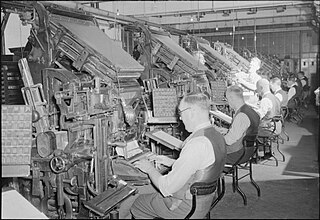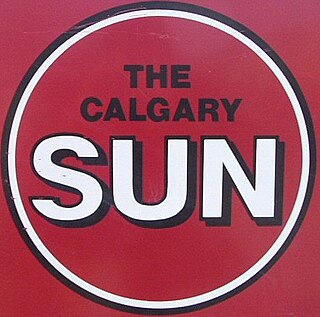
A tabloid is a newspaper with a compact page size smaller than broadsheet. There is no standard size for this newspaper format.

The history of British newspapers begins in the 17th century with the emergence of regular publications covering news and gossip. The relaxation of government censorship in the late 17th century led to a rise in publications, which in turn led to an increase in regulation throughout the 18th century. The Times began publication in 1785 and became the leading newspaper of the early 19th century, before the lifting of taxes on newspapers and technological innovations led to a boom in newspaper publishing in the late 19th century. Mass education and increasing affluence led to new papers such as the Daily Mail emerging at the end of the 19th century, aimed at lower middle-class readers.
Page 3, or Page Three, was a British newspaper convention of publishing a large image of a topless female glamour model on the third page of mainstream red-top tabloids. The Sun introduced the feature in November 1970, which boosted its readership and prompted competing tabloids—including The Daily Mirror, TheSunday People, and TheDaily Star—to begin featuring topless models on their own third pages. Well-known Page 3 models included Linda Lusardi, Samantha Fox, Debee Ashby, Maria Whittaker, Katie Price, Keeley Hazell,Dr Claire Tully and Jakki Degg.

The Daily Mirror is a British national daily tabloid newspaper. Founded in 1903, it is owned by parent company Reach plc. From 1985 to 1987, and from 1997 to 2002, the title on its masthead was simply The Mirror. It had an average daily print circulation of 716,923 in December 2016, dropping to 587,803 the following year. Its Sunday sister paper is the Sunday Mirror. Unlike other major British tabloids such as The Sun and the Daily Mail, the Mirror has no separate Scottish edition; this function is performed by the Daily Record and the Sunday Mail, which incorporate certain stories from the Mirror that are of Scottish significance.

Bildlit. 'Picture' or Bild-Zeitung, lit. 'Picture Newspaper' is a German tabloid newspaper published by Axel Springer SE. The paper is published from Monday to Saturday; on Sundays, its sister paper Bild am Sonntag is published instead, which has a different style and its own editors. Bild is tabloid in style but broadsheet in size. It is the best-selling European newspaper and has the sixteenth-largest circulation worldwide. Bild has been described as "notorious for its mix of gossip, inflammatory language, and sensationalism" and as having a huge influence on German politicians. Its nearest English-language stylistic and journalistic equivalent is often considered to be the British national newspaper The Sun, the second-highest-selling European tabloid newspaper.

The Baltimore Sun is the largest general-circulation daily newspaper based in the U.S. state of Maryland and provides coverage of local, regional, national, and international news.

The Sunday Sport is a British tabloid newspaper that was founded by David Sullivan in 1986. It mainly publishes images of topless female glamour models, and is well-known for publishing sensationalised, fictionalised, and satirical content, alongside celebrity gossip and sports coverage. It has changed from including legitimate journalism throughout its history. A sister title, the Daily Sport, was published from 1991 to 2011, when it ceased publication and went online-only, under separate ownership.

The Toronto Sun is an English-language tabloid newspaper published daily in Toronto, Ontario, Canada. The newspaper is one of several Sun tabloids published by Postmedia Network. The newspaper's offices are located at Postmedia Place in downtown Toronto.
An alternative newspaper is a type of newspaper that eschews comprehensive coverage of general news in favor of stylized reporting, opinionated reviews and columns, investigations into edgy topics and magazine-style feature stories highlighting local people and culture. Its news coverage is more locally focused, and their target audiences are younger than those of daily newspapers. Typically, alternative newspapers are published in tabloid format and printed on newsprint. Other names for such publications include alternative weekly, alternative newsweekly, and alt weekly, as the majority circulate on a weekly schedule.

The Winnipeg Sun is a daily tabloid newspaper in Winnipeg, Manitoba, Canada.

The Calgary Sun is a daily newspaper published in Calgary, Alberta, Canada. It is currently owned by Postmedia Network. First published in 1980, the tabloid-format daily newspaper replaced the long-running tabloid-size The Albertan soon after it was acquired by the publishers of the Toronto Sun. The newspaper, like most of those in the Canadian Sun chain, is known for short, snappy news stories aimed primarily at working-class readers. The layout of the Calgary Sun is partially based on that of British tabloids.

The Edmonton Sun is a daily newspaper and news website published in Edmonton, Alberta, Canada. It is owned by Postmedia following its 2015 acquisition of Sun Media from Quebecor.

The Ottawa Sun is a daily newspaper in Ottawa, Ontario, Canada. It is published by Sun Media. It began publication in 1983 as the Ottawa Sunday Herald, until it was acquired by (then) Toronto Sun Publishing Corporation in 1988. In April 2015, Sun Media papers were acquired by Postmedia.
OU Daily, formally known as The Oklahoma Daily, is the independent, student-produced newspaper at the University of Oklahoma, with a circulation of 6,000. Though it maintains a connection with OU's Gaylord College of Journalism and Mass Communication, the newspaper is not a part of required learning for journalism students at OU. Some classes, however, are offered at The Daily for academic credit.

Tabloid journalism is a popular style of largely sensationalist journalism which takes its name from the tabloid newspaper format: a small-sized newspaper also known as half broadsheet. The size became associated with sensationalism, and tabloid journalism replaced the earlier label of yellow journalism and scandal sheets. Not all newspapers associated with tabloid journalism are tabloid size, and not all tabloid-size newspapers engage in tabloid journalism; in particular, since around the year 2000 many broadsheet newspapers converted to the more compact tabloid format.
Jazz journalism was a term applied to American sensational newspapers in the 1920s. Focused on entertainment, celebrities, sports, scandal and crime, the style was a New York phenomenon, practiced primarily by three new tabloid-size daily newspapers in a fight for circulation. Convenient for readers on subways, the small-format papers were designed to display large page one photographs and headlines for newsstand sales. The tabloids' popularity was controversial, but also influenced the city's and nation's more traditional media, especially when columnist Walter Winchell became popular both in print and on the air.

A newspaper is a periodical publication containing written information about current events and is often typed in black ink with a white or gray background. Newspapers can cover a wide variety of fields such as politics, business, sports, art, and science. They often include materials such as opinion columns, weather forecasts, reviews of local services, obituaries, birth notices, crosswords, editorial cartoons, comic strips, and advice columns.
Postmedia Network Canada Corp. is a Canadian media conglomerate consisting of the publishing properties of the former Canwest, with primary operations in English-language newspaper publishing, news gathering and Internet operations. It is best known for being the owner of the National Post and the Financial Post. The company is headquartered at Postmedia Place on Bloor Street in Toronto.

Daily Voice is a South African tabloid newspaper that is distributed on weekdays and published by Independent Newspapers (Pty) Limited in the Western Cape province. It is published in English, with Afrikaans mixed in. In late 2013, the Daily Voice was the most-read daily newspaper in the Cape Town metropolitan area with 456,000 readers, and a total daily readership of 528,000.
Weekend was a long-running Canadian magazine and newspaper supplement. The Montreal Standard was founded in 1905 as a weekly newspaper and was purchased by the Montreal Star in 1925. In 1951 the Standard was relaunched in magazine format as Weekend Picture Magazine serving as a newspaper supplement for the Montreal Star and eight other local newspapers across Canada. Eventually shortening its name to Weekend, the magazine, printed using the rotogravure process, included features writing, cultural and entertainment reporting, cartoons by Doug Wright, colour advertising and photographs and recipes among other items. The magazine began with a circulation of 900,000 and peaked in the 1960s when it was carried in 41 newspapers and had a circulation of 2.5 million, making it the largest circulation magazine in Canada. In 1959 a French-language edition, Perspectives, was launched.













